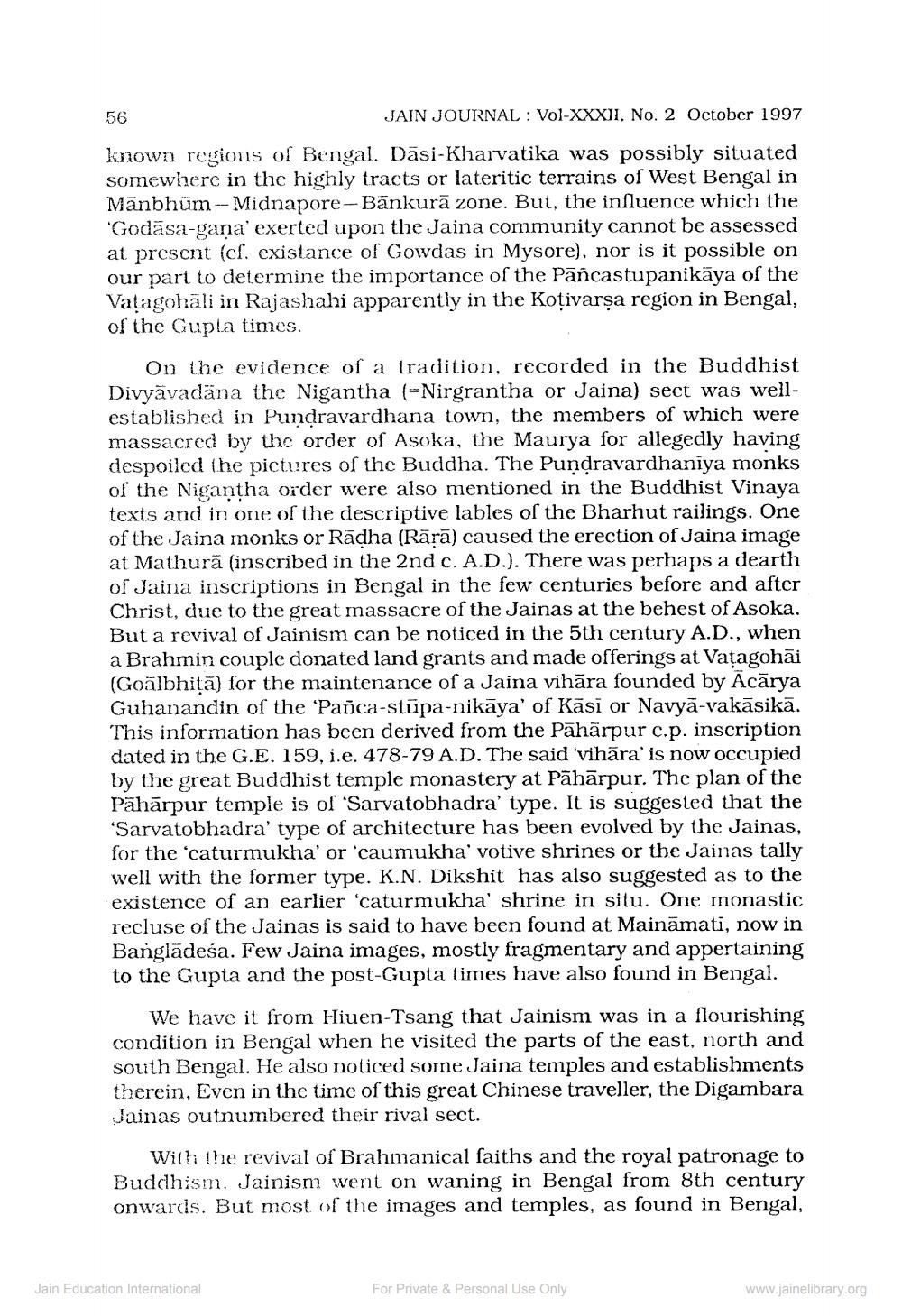________________
56
JAIN JOURNAL : Vol-XXXII, No. 2 October 1997
known regions of Bengal. Dāsi-Kharvatika was possibly situated somewhere in the highly tracts or lateritic terrains of West Bengal in Manbhum--Midnapore- Bänkurā zone. But, the insluence which the Godāsa-gana' exerted upon the Jaina community cannot be assessed at present (cf. cxistance of Gowdas in Mysore), nor is it possible on our part to determine the importance of the Pancastupanikaya of the Vatagohäli in Rajashahi apparently in the Kotivarsa region in Bengal, of the Gupta times.
On the evidence of a tradition, recorded in the Buddhist Divyāvadäna the Nigantha (=Nirgrantha or Jaina) sect was wellestablished in Pundravardhana town, the members of which were massacred by the order of Asoka, the Maurya for allegedly having despoiled the pictures of the Buddha. The Pundravardhaniya monks of the Nigantha order were also mentioned in the Buddhist Vinaya texts and in one of the descriptive lables of the Bharhut railings. One of the Jaina monks or Rādha (Rärā) caused the erection of Jaina image at Mathura (inscribed in the 2nd c. A.D.). There was perhaps a dearth of Jaina inscriptions in Bengal in the few centuries before and after Christ, due to the great massacre of the Jainas at the behest of Asoka. But a revival of Jainism can be noticed in the 5th century A.D., when a Brahmin couple donated land grants and made offerings at Vatagohāi (Goalbhitā) for the maintenance of a Jaina vihāra founded by Acārya Guhanandin of the ‘Panca-stūpa-nikāya' of Kāsi or Navyā-vakāsikā. This information has been derived from the Pāhärpur c.p. inscription dated in the G.E. 159, i.e. 478-79 A.D. The said 'vihāra' is now occupied by the great Buddhist temple monastery at Pāhārpur. The plan of the Pähārpur temple is of 'Sarvatobhadra' type. It is suggested that the 'Sarvatobhadra' type of architecture has been evolved by the Jainas, for the 'caturmukha' or 'caumukha' votive shrines or the Jainas tally well with the former type. K.N. Dikshit has also suggested as to the existence of an earlier 'caturmukha' shrine in situ. One monastic recluse of the Jainas is said to have been found at Maināmati, now in Bangladeša. Few Jaina images, mostly fragmentary and appertaining to the Gupta and the post-Gupta times have also found in Bengal.
We have it from Hiuen-Tsang that Jainism was in a flourishing condition in Bengal when he visited the parts of the east, north and south Bengal. He also noticed some Jaina temples and establishments therein, Even in the time of this great Chinese traveller, the Digambara Jainas outnumbered their rival sect.
With the revival of Brahmanical faiths and the royal patronage to Buddhism. Jainism went on waning in Bengal from 8th century onwards. But most of the images and temples, as found in Bengal,
Jain Education International
For Private & Personal Use Only
www.jainelibrary.org




